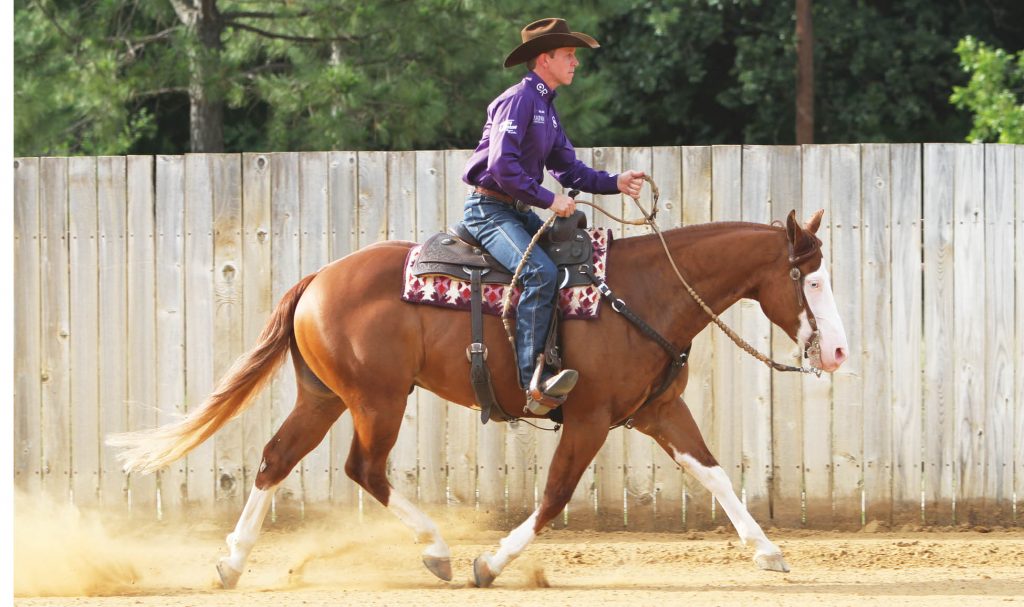Anytime you show, it’s crucial to think about what you’ll do and how you’ll do it ahead of your class, no matter the event. But ranch riding might require even more strategy and planning simply because there aren’t any markers in the pen and the execution of the pattern is up to your interpretation. Strategizing and planning ahead of time allows you to determine the best way to lay out your pattern, show your horse’s strengths, avoid any weaknesses, and present a pattern the judges won’t forget.
Here are my six tips for your preparation process anytime you compete in ranch riding. If you show in other events, try these out and see how they work for you, too.

Tip 1: Think Outside the Drawing
The patterns themselves are just guidelines. Ranch riding patterns have more room for execution than something stricter like a reining pattern. You don’t have to perform it exactly as it says on the page. I advise paying more attention to the words describing the pattern than the drawing itself.
Planning your pattern in this way allows you to account for things such as arenas of different lengths and widths and those that are more square than oblong. The arena’s shape provides a major determining factor for how your pattern will come together.
Additionally, when you look at the lines on the page, lines that might overlap in the execution of the pattern are separated on the page. This doesn’t mean the judges expect you to create that separation when you perform the pattern. For example, the pattern might designate to lope clockwise around part of the perimeter of the arena, and then in another part it requires you to trot that same perimeter counter-clockwise. Those lines won’t be on top of each other, even though the elements happen in the same place. There’s no need to separate them when you execute the pattern.
Tip 2: Take a Walk
While your horse settles in, head to the arena where you’ll show. With your pattern in mind, walk the arena to get a feel for where the elements will play out and how they best flow together. You know exactly where some elements of the pattern will lie—your starting point and the logs, for example. Walking around on foot allows you to get your bearings before you bring your horse into the picture. Spatial awareness and arena awareness are key to presenting the best pattern possible.
Tip 3: Make Your Marks
Identify sponsor banners, panel connections, marks on the arena wall, and more that can indicate where to transition from one maneuver to the next. If you’re outside, find trees, shrubs, an outbuilding that can help remind you when to speed up, slow down, circle, and more.

Tip 4: Walk and Trot It
Saddle up your horse, and head to the pen where you’ll show. Walk and trot pieces of the pattern to get a feel for where elements will fall, where you can take your time, when you might need to be quicker in your transitions, and how you’ll approach each piece. Walking and trotting allows you to focus on your place in the pen rather than schooling your horse. It slows everything down so you can really think through your task. It also can help alleviate anticipation.
Tip 5: Practice Parts
You’ve probably heard this a million times, but I still see people doing it: Avoid practicing your pattern over and over. It sets up you and your horse for failure. Horses are smart; they can learn these patterns, and then they’ll start to anticipate.
Instead, focus on doing small parts of the pattern. Separate the maneuvers or break the pattern into sections. If you do practice the entire pattern, only do it once or twice. Anything more than that can be problematic because your horse learns what’s coming and then starts to think ahead of you.
Tip 6: Know Your Horse
This might be the most important thing to remember: Knowing your horse’s tendencies makes a huge difference in how you’ll strategize for your pattern. What do you know about your horse from practicing at home? How about from competing at other shows? What has he told you that could make or break your pattern? Is he less sensitive to one cue than the others? Where is he more sensitive?
Our standard of excellence in ranch riding is to complete transitions in two strides—one stride is even better. Showing this skill to the judges can earn you credit when used correctly. The time you spend riding at home and showing gives you the ability to identify these strengths and capitalize on them.
However, if you know your horse tends to be delayed in his reaction to your cue to lope off or to slow down, for example, consider this in how you plan your transitions. Start setting up and executing your cue earlier than you would need to if your horse was ultra-responsive. If you don’t plan for your horse’s slow response, you could be all the way around the end of the arena before you achieve the transition. While this won’t be a penalty on your scorecard, it could impact your maneuver score, making a 0 transition a -½, for example, and it could’ve been avoided by knowing your horse and helping him through a place he usually struggles.






